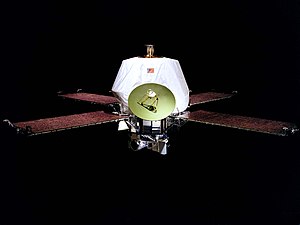Program Mariner
Program Mariner (pol. Żeglarz) – program misji amerykańskich sond kosmicznych przeznaczonych do prowadzenia badań Merkurego, Wenus i Marsa.
Program Mariner został zapoczątkowany przez NASA w 1960 roku i realizowany był przez Jet Propulsion Laboratory. W latach 1962 – 1973 zostało wysłanych łącznie 10 sond Mariner, spośród których 3 uległy zniszczeniu lub awarii podczas startu. Sondy Mariner dokonały pierwszych udanych przelotów obok najbliższych Ziemi planet i wykonały pierwsze fotografie z bliska powierzchni Marsa i Merkurego. Mariner 9 stał się pierwszym sztucznym satelitą innej planety. Mariner 10 wykonał pierwszy manewr wspomagania grawitacyjnego.
Całkowity koszt misji sond programu Mariner wyniósł około 554 milionów dolarów amerykańskich.
Lista misji programu Mariner
| Nazwa | Data startu | Zadania | Uwagi |
|---|---|---|---|
| Mariner 1 | 22 lipca 1962 | Przelot obok Wenus | Niepowodzenie Awaria rakiety nośnej |
| Mariner 2 | 27 sierpnia 1962 | Przelot obok Wenus | Sukces |
| Mariner 3 | 5 listopada 1964 | Przelot obok Marsa | Niepowodzenie Awaria sondy podczas startu |
| Mariner 4 | 28 listopada 1964 | Przelot obok Marsa | Sukces |
| Mariner 5 | 14 czerwca 1967 | Przelot obok Wenus | Sukces |
| Mariner 6 | 25 lutego 1969 | Przelot obok Marsa | Sukces |
| Mariner 7 | 27 marca 1969 | Przelot obok Marsa | Sukces |
| Mariner 8 | 9 maja 1971 | Sztuczny satelita Marsa | Niepowodzenie Awaria rakiety nośnej |
| Mariner 9 | 30 maja 1971 | Sztuczny satelita Marsa | Sukces |
| Mariner 10 | 3 listopada 1973 | Przelot obok Wenus i trzykrotne przeloty obok Merkurego | Sukces |
Zobacz też
Linki zewnętrzne
- Jet Propulsion Laboratory: JPL Past Missions. [dostęp 2013-07-24]. [zarchiwizowane z tego adresu (2013-07-28)].Sprawdź autora:1.
- Jet Propulsion Laboratory: Mariner Fact Sheet.Sprawdź autora:1.
- NASA History Division: Mariner Space Probes.Sprawdź autora:1.
- Asif A. Siddiqi: Deep Space Chronicle: A Chronology of Deep Space and Planetary Probes 1958–2000. NASA SP-2002-4524, czerwiec 2002.
- Bernd Leitenberger: Die Mariner Missionen (niem.).
Media użyte na tej stronie
Внешний вид АМС "Маринер-9".
Mariner program probes overview.
Original Caption Released with NASA Image:





